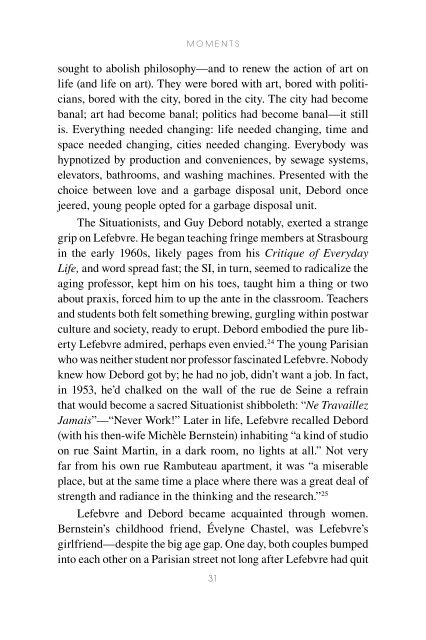Henri Lefebvre: A Critical Introduction - autonomous learning
Henri Lefebvre: A Critical Introduction - autonomous learning
Henri Lefebvre: A Critical Introduction - autonomous learning
Create successful ePaper yourself
Turn your PDF publications into a flip-book with our unique Google optimized e-Paper software.
M o M e n t s<br />
sought to abolish philosophy—and to renew the action of art on<br />
life (and life on art). They were bored with art, bored with politicians,<br />
bored with the city, bored in the city. The city had become<br />
banal; art had become banal; politics had become banal—it still<br />
is. Everything needed changing: life needed changing, time and<br />
space needed changing, cities needed changing. Everybody was<br />
hypnotized by production and conveniences, by sewage systems,<br />
elevators, bathrooms, and washing machines. Presented with the<br />
choice between love and a garbage disposal unit, Debord once<br />
jeered, young people opted for a garbage disposal unit.<br />
The Situationists, and Guy Debord notably, exerted a strange<br />
grip on <strong>Lefebvre</strong>. He began teaching fringe members at Strasbourg<br />
in the early 1960s, likely pages from his Critique of Everyday<br />
Life, and word spread fast; the SI, in turn, seemed to radicalize the<br />
aging professor, kept him on his toes, taught him a thing or two<br />
about praxis, forced him to up the ante in the classroom. Teachers<br />
and students both felt something brewing, gurgling within postwar<br />
culture and society, ready to erupt. Debord embodied the pure liberty<br />
<strong>Lefebvre</strong> admired, perhaps even envied. 24 The young Parisian<br />
who was neither student nor professor fascinated <strong>Lefebvre</strong>. Nobody<br />
knew how Debord got by; he had no job, didn’t want a job. In fact,<br />
in 1953, he’d chalked on the wall of the rue de Seine a refrain<br />
that would become a sacred Situationist shibboleth: “Ne Travaillez<br />
Jamais”—“Never Work!” Later in life, <strong>Lefebvre</strong> recalled Debord<br />
(with his then-wife Michèle Bernstein) inhabiting “a kind of studio<br />
on rue Saint Martin, in a dark room, no lights at all.” Not very<br />
far from his own rue Rambuteau apartment, it was “a miserable<br />
place, but at the same time a place where there was a great deal of<br />
strength and radiance in the thinking and the research.” 25<br />
<strong>Lefebvre</strong> and Debord became acquainted through women.<br />
Bernstein’s childhood friend, Évelyne Chastel, was <strong>Lefebvre</strong>’s<br />
girlfriend—despite the big age gap. One day, both couples bumped<br />
into each other on a Parisian street not long after <strong>Lefebvre</strong> had quit<br />
31
















